Animation is doing well everywhere this year, including the foreign-language category of the Oscars.
The post ‘My Life as a Zucchini’ Among Nine Films That Advances in Foreign Oscar Shortlist appeared first on Cartoon Brew.
Add a Comment
Animation is doing well everywhere this year, including the foreign-language category of the Oscars.
The post ‘My Life as a Zucchini’ Among Nine Films That Advances in Foreign Oscar Shortlist appeared first on Cartoon Brew.
Add a Comment
This festival favorite is headed to North America thanks to GKIDS.
The post GKIDS Acquires Swiss Oscar Contender ‘My Life As A Zucchini’ appeared first on Cartoon Brew.
Add a Comment
A big hit at Cannes and Annecy, the Oscar-contending "Ma Vie de Courgette" now has an English-subbed trailer.
The post Swiss Oscar Contender ‘Ma Vie de Courgette’ Unveils English-Subbed Trailer appeared first on Cartoon Brew.
Add a Comment
Claude Barras' breakout animation debut "My Life As a Courgette" will represent Switzerland at the Academy Awards.
The post Switzerland Selects ‘My Life As A Courgette’ As Foreign-Language Oscar Entry appeared first on Cartoon Brew.
Add a Comment
In a world inhabited by strange creatures, a cat endeavors to find her place within it.
The post ‘Mind the Cat’ by Elena Schönfeld and Martine Ulmer appeared first on Cartoon Brew.
Add a Comment
My co-author Philip Reeve and I were so excited to get a message from our International Rights Manager Stella Giatrakou, saying she'd heard from French publisher Seuil that Oliver and the Seawigs had won an award in Switzerland! It's the Prix Enfantaisie, organised by Payot bookshops and the Swiss Institute for Youth, and they've been doing it for 20 years; 3,000 children voted for Oliver et les îles vagabondes from a selection of five books. 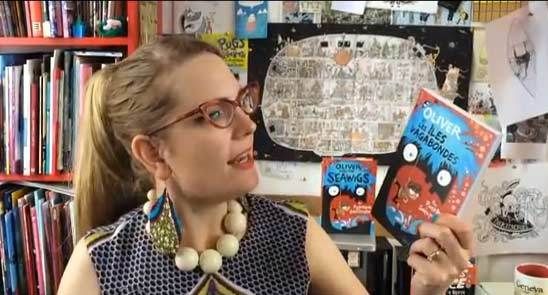
We weren't able to go to the Geneva International Bookfair to accept the award because we had already agreed to go to the Stratford-upon-Avon lit fest. But I knew the perfect person in Geneva to collect the award! She's Marie-Pierre Preece, the amazing librarian at the International School of Geneva, that I visited in 2012. (All the kids call her 'MP'.) Here she is on the left, with the picture I drew for her library during my visit: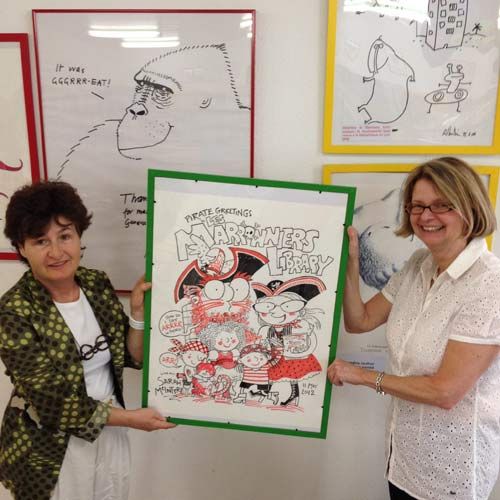
And MP asked Philip and me if we could make a video for the ceremony, which we did. (Note the excellent sound effect halfway through, that was Philip's doing.)
Yes, thank you, Payot, Seuil, our excellent French translator Raphaële Eschenbrenner, Stella at Oxford University Press, and MP! Here's MP collecting the award at the book fair, next to the winner in the other category, Max Ducos, for Le Mystère de la grande dune. 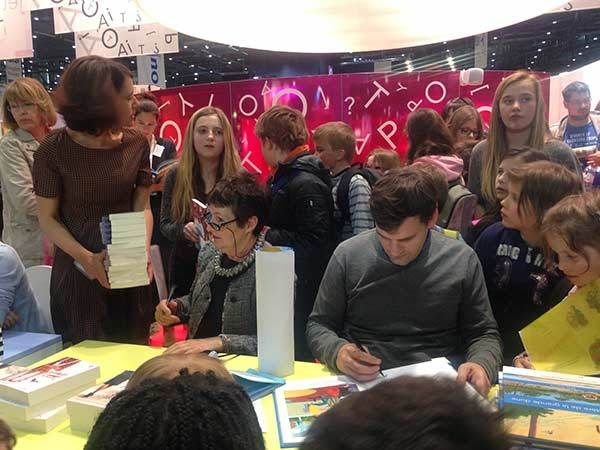
And MP signing our books! She wrote in an e-mail:
The second picture is me signing your book. The kids asked for a signature and I said, 'Well how, if the illustrator is not here?' and then one of them said, 'But you, Miss, can't you sign our books?' and I couldn't resist! But I signed 'de la part de', so all is honest and good. 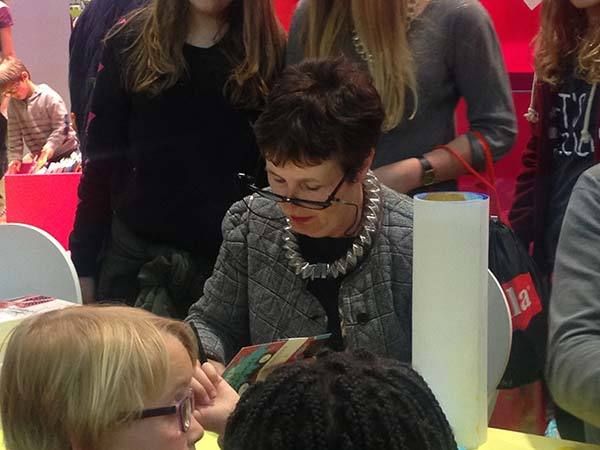
Some of the kids spoke English and were able to understand the video, and MP translated for the rest. They also had some questions. So I rang up Philip on Skype this morning and we've answered them together. A big thanks to everyone who voted for our book!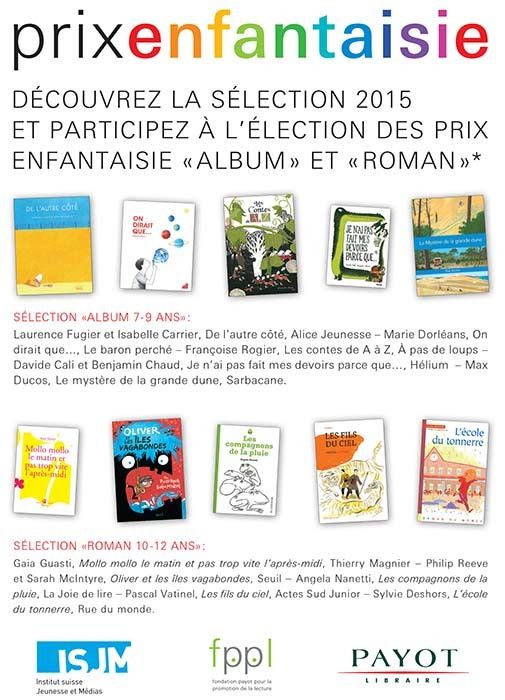
Questions from Swiss readers:
* Did you use a computer to create the illustrations?
Partly, yes! I started out by using old-fashioned dip pen and ink, and scanned those black-and-white drawings into the computer. In Adobe Photoshop, I added the blue colour (which is gray in some of the paperback versions). 
* Where did the idea of vagabond islands come from?
Sarah: Philip had the idea to write a sea story, and we originally thought it might be about a dog that washed up on a beach. But I was telling Philip about how I'd been to a meeting of the Children's Writers & Illustrators Group (part of the Society of Authors), and the acronym for that is 'CWIG'. I pronounced it 'Seawig', and joked that I'd love to draw a picture of islands with stuff piled up on their heads. (I'd just been drawing a lot of monster wigs for an exhibition.) Philip said, 'AHA! That's just what we need for this story!' and it all started from there.
* Why did you choose the sea and not another type of environment?
Sarah: Philip and I both grew up near the sea and love it. The sea is also the closest thing on earth that we have to an alien planet; scientists are still discovering strange alien creatures in its depths. So it's natural to think that any kind of creature could come out of it. 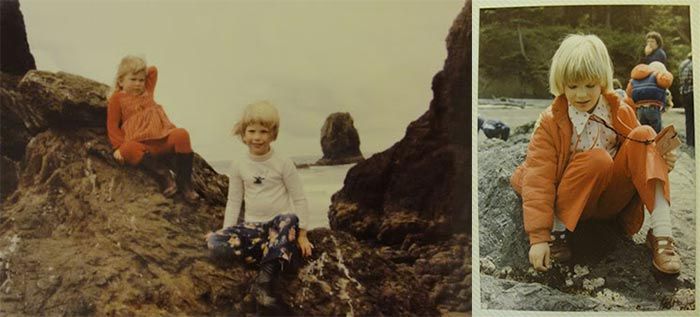
Little Sarah with her sister, Mary
* Where did you get the idea of the characters in the book?
Philip: We wanted a character who could go off and have adventures so we made his family explorers. Sarah really likes mermaids, so we decided we'd have him meet a mermaid. And the other characters just popped in when they felt like it.
* Why is the boy called Oliver? is there a link with somebody you know?
Philip: We were walking along the banks of the Thames while we talked about this story and we came to a place called Oliver's Wharf...
* Where did the idea of Sea Monkeys come from?
Sarah: From comics! In the American Archie comics I read growing up, there was always an advert for Sea Monkeys, and I never believed that, for only a dollar, they would look like the ones in the picture. But I did wonder about them.
* Did you go around the world like Oliver's parents?
Philip: When I was little, my parents took me around England, Scotland and Wales in a campervan, a bit like Oliver's Explorermobile.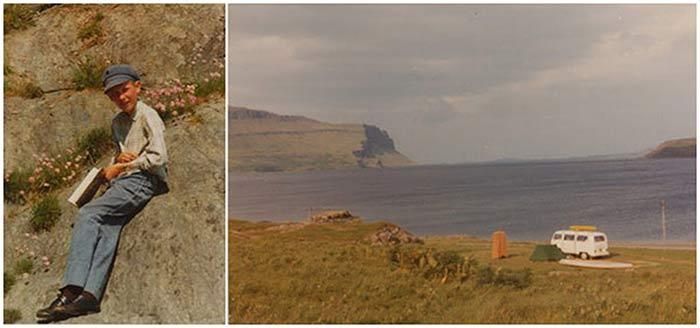
Sarah: I grew up in Seattle and did travel quite a bit with my parents, to places in the USA and to Scotland, England and France. Recently we all went to China together, and I made a travel comic about it that you can read here. 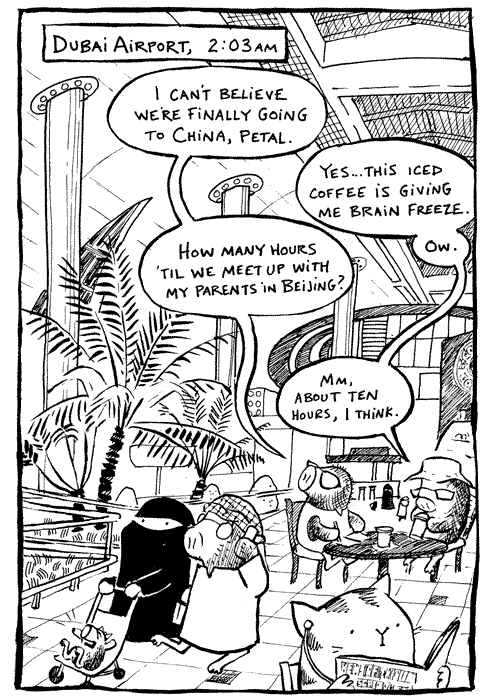
* Did other books inspire you?
Philip: Yes, but too many to name.
Sarah: In the beginning of creating our story, I thought a little bit about The Voyage of the Dawn Treader in the Narnia books, and the seagull in Watership Down, but by the time we'd finished creating our story, it was something completely different.
* How long did it take to write the book?
Philip: Including all the illustrations, about a year? We came up with the ideas together and I went away and wrote it, which took about a month.
* What books did you like as a kid?
Philip: Tolkien, Asterix, Tintin, Rosemary Sutcliffe.
Sarah: The Twenty-one Balloons by William Pené du Bois, In the Night Kitchen by Maurice Sendak, collections of Calvin & Hobbes comics.
* What are your favourite books?
Philip & Sarah: We both love Geraldine McCaughrean's The White Darkness.
* Why did you become writers and illustrators?
Philip: Because there's nothing else I can do!
Sarah: I've always loved drawing and writing gives me the chance to decide what I'm going to draw.
* Since when have you been a writer?
Philip: Since I was five. But my first published book was in 2001, Mortal Engines.
Sarah: Me, too, since about five. I made a book called My Fish. (You can read it all here.)
* Did you go to a special school to become writers and illustrators?
Philip: I went to art college but mostly I learned to write by just writing.
Sarah: I studied Russian at university, with a focus on Russian language and literature. But then I lived in Moscow for two years and discovered amazing Russian art and got very inspired. Over the next six years, I illustrated quite a few books and then went to art college for two years to study illustration. 
* How is it to live an author's life, how do you organise your days?
Philip: I don't organise my days, they just happen.
Sarah: Days can be so different! One day I might be working at my desk, then the next day I might be traveling to talk about my books in front of hundreds of people on stage. 
* Do you have another job?
Philip: I do illustrate sometimes for other writers.
Sarah: Sometime publicising the books feels like a whole second job! I once wrote an article about how I have a fleet of clones helping me with all the work involved in being an illustrator.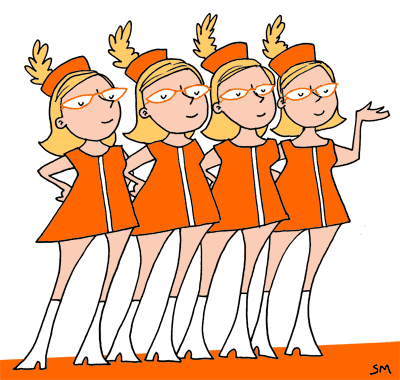
* Will there be a follow up?
Sarah: Yes! The characters won't be the same - Philip and I wanted to come up with whole new worlds for each book - but they'll all be adventure stories. We've published one called Cakes in Space (or Astra et les gâteaux de l'espace in French, published by Seuil). You can learn how to draw some of the characters here on my website. And our next book is coming out in English, Pugs of the Frozen North, and hopefully in French, too! 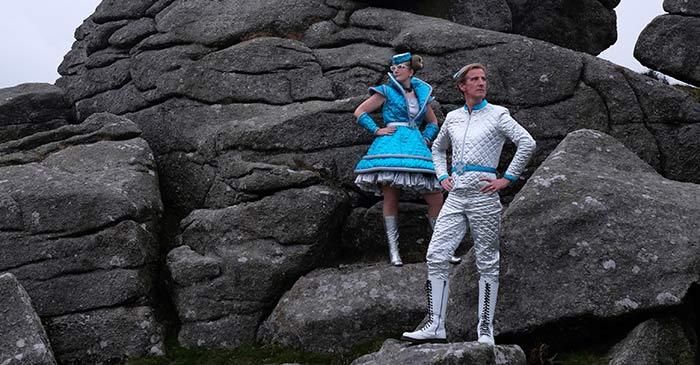
Photo by Sarah Reeve
Cocoa and chocolate have a long history in Central America but a relatively short history in the rest of the world. For thousands of years tribes and empires in Central America produced cocoa and consumed drinks based on it. It was only when the Spanish arrived in those regions that the rest of the world learned about it. Initially, cocoa production stayed in the original production regions, but with the local population decimated by war and imported diseases, slave labor was imported from Africa.
The ‘First Great Chocolate Boom’ occurred at the end of the 19th and early 20th century. The industrial revolution turned chocolate from a drink to a solid food full of energy and raised incomes of the poor. As a result, chocolate consumption increased rapidly in Europe and North America.
As the popularity of chocolate grew, production spread across the world to satisfy increasing demand. Interestingly, cocoa only arrived in West Africa in the early 20th century. But by the 1960s West Africa dominated global cocoa production, and in particular Ghana and Ivory Coast have become the world’s leading cocoa producers and exporters.
Not surprisingly, given the growth in trade of cocoa and consumption of chocolate, governments have intervened in the markets through various types of regulations. The early regulations (in the 16th–19th centuries) focused mostly on extracting revenue from cocoa production and trade through, for example, taxes on cocoa trade and the sales of monopoly rights for chocolate production.
The world is currently experiencing a ‘Second Great Chocolate Boom.’
More recent regulations have focused mostly on quality and safety. With growing demand for chocolate in the 19th century, chocolate producers substituted cocoa with cheaper raw materials, going from various starchy products and fats to poisonous ingredients. Scientific inventions of the 18th and 19th centuries allowed better testing of the chocolate ingredients. Public outrage against the use of unhealthy ingredients (now scientifically proven), led to a series of safety regulations on which specific ingredients were not allowed in chocolate – and in countries such as France and Belgium also in a legal definition of ‘chocolate’.
Chocolate consumption has many fascinating aspects. It is bought both for the pleasure of consumption and as a gift. It has been considered a healthy food, a sinful indulgence, an aphrodisiac, and the cause of obesity.
For much of history, chocolate (or cocoa drinks more generally) was praised for its positive effects on health and nutrition (and other benefits for the human body). As people were poor, hungry, and short of energy, chocolate drinks and later chocolate bars became an important additional source of nutrition.
In recent years, chocolate consumption is often associated with negative health issues, such as obesity. Recent research has shown that its health potential is closely linked to the composition of the final product and, not surprisingly, to the quantity consumed: darker, lower-fat, and lower-sugar varieties, consumed in a balanced diet are more likely to be healthy than the opposite consumption pattern.

In today’s high income societies where hunger is an exception, food is cheap, and obesity is on the rise, systematic overconsumption of chocolate – often associated with impulsive consumption and lack of self-control – is more associated with health problems. New research in behavioral engineering is targeted to help consumers deal with situational influences, and change behavior in a sustainable way, i.e. by ‘nudging’ them to change their consumption behavior and resisting the lure of chocolate.
One of the intriguing aspects of chocolate is its ‘quality’. Different from many other foods (such as cheese or wine) perceived chocolate quality is not related to the location where the raw material is grown or produced, but to the chocolate manufacturing process and location.
Some countries, such as Switzerland and Belgium are associated with prestigious traditions of chocolate manufacturing. However, perceptions do not always fit reality. ‘Belgian chocolates’, such as pralines and truffles, are now world famous but until 1960, Belgium imported more chocolate than it exported. Since then its “Belgian chocolates” have conquered the world – while the world has taken over the Belgian chocolate (companies). Most “Belgian chocolates” are now owned by international holdings – and a sizeable amount is produced outside the country.
Moreover, consumer perceptions of ‘quality’ are strongly influenced by consumer experiences with their local chocolate – this includes the smoothness of Swiss chocolate from long conching, the milkiness of British chocolate, and the preference of American consumers for chocolate that Europeans consider inferior.
In fact, the integration of the UK, Ireland and Denmark into the (precursor of the) European Union, which included France and Belgium in 1973 resulted in a ‘Chocolate War’ which lasted for 30 years. Disputes between the old and the new member states of the definition of “Chocolate” (and its ingredients) made that British chocolate was banned from much of the EU continent for three decades.
Ethical concerns about chocolate have been triggered by the specific structure of the structure of the global cocoa-chocolate value chain. For most of the past century, the value chain was characterized by a South-to-North orientation, with most of the raw material (cocoa beans) produced in developing countries (‘the South’) and most chocolate manufacturing and consumption in the richer countries (‘the North’). Another characteristic is that cocoa production in the South is almost exclusively by smallholders, while cocoa grinding and (first stage) chocolate manufacturing processes are often dominated by very large companies.
The cocoa-chocolate value chain has undergone significant transformations in recent years. First, in the 1960s through the 1980s the cocoa production and marketing in developing countries was strongly state regulated, often dominated by (para-)statal companies and state regulated prices and trade, etc. In recent years there has been substantial liberalizations of these sectors and the market plays a much larger role in price setting and trading, often resulting in new hybrid forms of ‘public-private governance’ of the world’s cocoa farmers.
Second, these new regulatory systems are reinforced by consumer awareness around labour conditions and low incomes in African smallholder production related to structural imbalances in the value chain. Consumer concerns and civil society campaigns around poor socio-economic conditions of producers (such as child labor) have affected companies’ strategies and responses. These involved (a) sustainability initiatives with civil society and governments, (b) certification initiatives including Fairtrade, Rainforest Alliance and Utz, and (c) various forms of Corporate Social Responsibility (CSR) activities.
The world is currently experiencing a ‘Second Great Chocolate Boom’. Rapidly growing demand is now not coming from ‘the North’, but from rapidly growing developing and emerging countries, including China, India and also Africa. The unprecedented growth of the past decades, the associated urbanization, and the huge size of their economies have turned China and India into major growth markets for chocolate. While consumption is highest in China, and the growth is strong, the country with – by far – the highest growth rates in chocolate consumption is India. In addition, significant African growth of the past 15 years is now also translating into growing chocolate consumption on the continent where most of the cocoa beans are produced.
Headline image: Fresh Cacao from São Tomé & Príncipe, by Everjean. CC-BY-2.0 via Flickr.
The post The economics of chocolate appeared first on OUPblog.
In September 1965, Hurricane Betsy devastated parts of Florida and the central United States Gulf Coast. The damage was estimated at $1 billion – so far the costliest natural disaster in US history. In August 1992, Hurricane Andrew made havoc to towns and cities on The Bahamas and in Louisiana and Florida. This time, the damage amounted to $26.5 billion – again so far the costliest natural disaster in US history. In August 2005, Hurricane Katrina devastated parts of the United States Gulf Coast. The proud and old city of New Orleans was inundated. The total damage from Katrina amounted to $81.2 billion, twice as much as the damage from Hurricane Andrew, when adjusted for inflation. So far, Hurricane Katrina has been the costliest natural disaster in world history.
In other words, extreme events have caused increasingly extreme damage, and each time the jump in costs came as a surprise. Yet, although not anticipated, these extreme events did not cause any major economic disruption in the US or global economy. This is not to say, that the regions and people most affected by the hurricanes were not suffering from unemployment and economic hardship thereafter. But given the huge losses and the importance of the United States for the global economy, the lack of serious negative economic consequences is rather striking. The hurricanes were followed by bankruptcies of insurance companies, but the sector as whole stayed firm.
How can we explain this resilience? Why was the insurance sector not overwhelmed by these extreme events? The main reason is that an innovation that was introduced in Central Europe about 150 years ago has fundamentally transformed the risk landscape. It is called reinsurance. With the growing complexity of the economic system in the 19th century, the reinsurance industry provided a backstop for the increasingly large insurance deals with industrial firms, shipping companies or government agencies. By providing huge reserves for extreme losses, the reinsurance industry enabled entrepreneurs, managers or bankers to take risks that would have been out of reach without the reinsurance industry. In the second half of the 19th century and ever since, the reinsurance industry has become as essential to the modern economy as the credit system, the transportation network or the energy supplies.The oldest reinsurance company that has kept its original name is the company Swiss Re whose headquarters are located in Zurich, Switzerland. Its historical records are exceptionally rich and cover all the major themes in the history of the reinsurance industry since 1863, in particular the strong growth and internationalization in the late 19th and early 20th century, the San Francisco earthquake of 1906, the impact of booms, busts and wars between 1914 and 1945, the challenges emanating from new technologies such as atomic energy after 1945, and the transformation of the reinsurance industry by the rise of financial capitalism in the last thirty years.
These rich archives shed light not only on the development of the modern world, but also on the exciting dynamics of an industry which remains ostensibly invisible while collecting dozens of billions of dollars in net premiums, every single year. In 2012, they amounted to nearly $150 billion. The reinsurance industry is perhaps the biggest hidden pillar of the modern world economy.
David Gugerli is a Professor of History at the Department of Humanities, Social and Political Sciences of the Federal Institute of Technology (ETH) in Zurich. His main interest is in the history of technology and science, social and economic history and cultural history. Tobias Straumann is Lecturer in the History Department of the University of Zurich and the Economics Department of the University of Basel. Dr. Straumann has worked in the fields of Swiss business history and European financial and monetary history. They are two of the co-authors of The Value of Risk: Swiss Re and the History of Reinsurance.
Subscribe to the OUPblog via email or RSS.
Subscribe to only business and economics articles on the OUPblog via email or RSS.
Image credit: London Swiss Re Building. By Mariordo Mario Roberto Duran Ortiz. CC-BY-SA-3.0 via Wikimedia Commons
The post A hidden pillar of the modern world economy appeared first on OUPblog.
I’m very impressed with these posters from Felix Pfaeffli, an accomplished young designer from Luzern who is producing very polished and mature work for his age. In addition to running his own studio he is a teacher at the Lucerne School of Graphic Design where he lectures on typography, narrative design, and poster design.
——————–
Also worth viewing:
Ross Gunter
Philographics
Lufthansa + Graphic Design
Not signed up for the Grain Edit RSS Feed yet? Give it a try. Its free and yummy.
——————–
Thanks to Mister Retro: Machine Wash Deluxe for being this week's sponsor.
The daughter of the highly influential designer Niklaus Troxler, Annik has created a strong body of work that has a unique voice of its own. Her posters have won many awards including the coveted International Poster Festival in Chaumont, France and the Swiss Federal Competition for Design. This has allowed for some unique opportunities including the chance to collaborate with Mevis & Van Deursen in Amsterdam. In 2011, she returned to her native Switzerland to open an independent studio and began a teaching position at the renowned Basel School of Design.
—-
Also worth viewing
Elana Schlenker
Jonny Holmes / Bodoni
Recently Received
Not signed up for the Grain Edit RSS Feed yet? Give it a try. Its free and yummy.
Thanks to Mighty Deals for being this week's sponsor.
Josef Müller-Brockmann’s graphics left a lasting mark on Swiss visual communication from the 1950s onward. His posters demonstrate how a sober, formally reduced language works best for conveying a universal, timeless message. Poster campaigns for longtime clients such as the Tonhalle concert hall in Zürich or the Automobile Club of Switzerland follow strict functional criteria–and yet exhibit a variety of design solutions and exciting, dynamic compositions.
This book presents selected posters by Müller-Brockmann and places them in the context of their own time while also examining the validity of his solutions from today’s point of view.
Pre-order a copy via Lars Muller, Amazon or your local bookstore.
——————–
Also worth viewing…
Herb Lubalin: American Graphic Designer
Wim Crouwel: A Graphic Odyssey
Recently Received Books
Maggie Steele, the storybook heroine who vaults over the moon, has been attracting thousands of visitors from around the world. So many visitors, in fact, that she’s using a time zone map to keep track of them all.* People are … Continue reading ![]()
Marcus Kraft is an award-winning multidiscplinary studio located in Zurich, Switzerland. Their diverse portfolio ranges from editorial pieces that are bold and confrontational to posters that are more subtle and nuanced in their approach.
——————–
Also worth viewing…
Heartwork 2011
Jason Munn Interview
Jessica Hische Studio Visit
Not signed up for the Grain Edit RSS Feed yet? Give it a try. Its free and yummy.
Andreas Hidber is an accomplished designer out of Basel, Switzerland. Although his specialty is editorial design, Hidber also dabbles in branding and corporate identity.
The first piece that caught my eye was a newspaper designed for the JFK Festival for Youth Culture where he rotated every single element 45°.
In another piece, Hidber collaborates to provide a chronicle of the most recent design undertakings coming out of the Harvard Graduate School of Design.
Other work by Andreas
—–
Also worth viewing:
Herbert Matter documentary
Mark Gowing
Carl DeTorres
Not signed up for the Grain Edit RSS Feed yet? Give it a try. Its free and yummy.
Featured Book: Matte Stephens: Selected Works.
If you missed The Visual Language of Herbert Matter at your local theater you can now pick up a copy of the film at iTunes or Amazon. The 78-minute documentary directed by Reto Caduff traces Herbert’s life and work and includes interviews with design luminaries such as Steven Heller, Jessica Helfand, Robert Frank and Massimo Vignelli.
From the website:
With the help of historical footage, vintage photographs, never-before-seen film excerpts (some shot by Matter himself) and a broad overwiew of his extensive body of work, the feature length documentary helps in bringing the picture of an almost forgotten creative genius back into focus.
Interwoven with interviews from a who’s who list of legendary artists, designer and photographers, the film sheds light on a remarkable career and its impact on the evolving language of design during the short 20th century both in the USA and Europe.
For the first time in an encompassing and comprehensive way, the film touches on the innovative expressions of his free experimental work, his fashion and advertising photography and his portraiture. His amazing talent of combining bold combinations of words, images and space is shown in his iconic Swiss travel posters, pavilion designs for the New York World’s Fair 1939, photographs for Condé Nast publications; corporate image programs for Knoll furniture, the New Haven Railroad, exhibition- and numerous catalog designs for the Museum of Modern Art and the Guggenheim Museum; covers for the legendary Arts & Architecture magazine and his lesser known work in film, the prime example being a film on the works of Alexander Calder.
Also available in Europe (PAL Format).
——————–
Also worth checking:
Swiss Graphic Design by Geigy,
Jorg Hamburger,
Hans Hartmann,
Zurich Map
Not signed up for the Grain Edit RSS Feed yet? Give it a try. Its free and yummy.
——————–
Add a Comment
This week I went on my first-ever trip to Switzerland! I used to pride myself on travelling lightly, just a tiny rucksack, but I never used to travel around foreign cities wearing big hats or dressed as a pirate. Some of the morning commuters on the Geneva trams looked a bit surprised.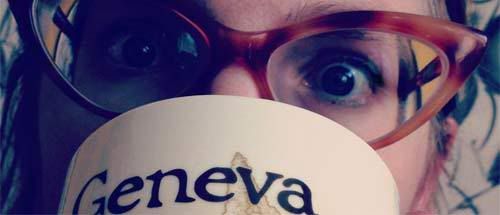
The head librarian of the International School of Geneva invited me to come to her school after getting a lovely recommendation from writer and illustrator Nick Sharratt (thanks, Nick!) and I jumped at the chance. 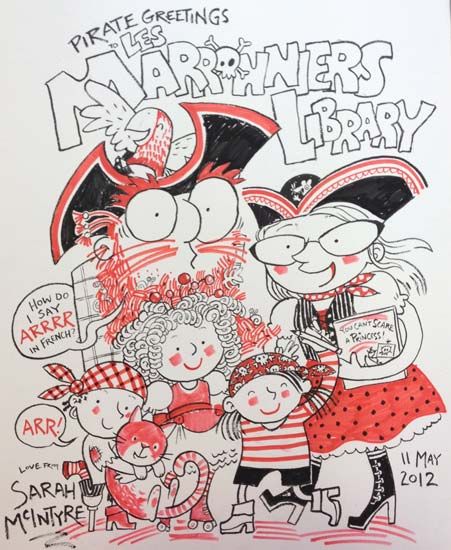
It's a beautiful school. There are lots of International Schools all over the world, but this one was the first.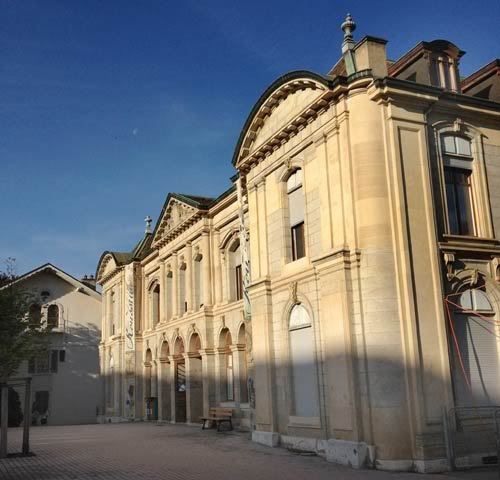
I always wanted a job that would let me travel to cool places! I liked this comics panel that one of the children there drew:
'I knew this day would come.' 'Never! Well, maybe in your dreams.' ...Ace!
When I was little, we only ever got to have those mini boxes of sugar cereals when we were on holiday. 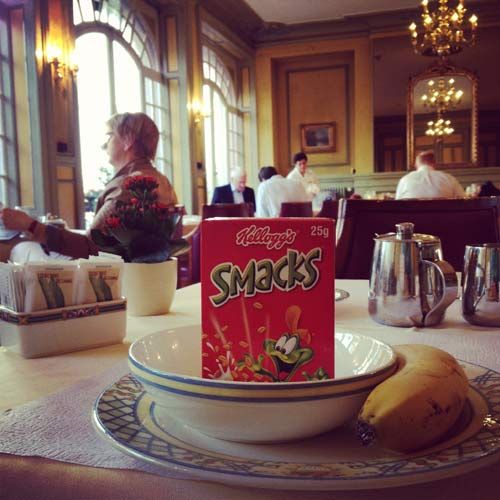
I got to do lots and lots of drawing! Not careful, well-thought-out pictures, just fun, fast, scrappy stuff that the kids thought up. The first day was a comics day, so I didn't dress up as a pirate. (But I still wore a fancy hat. It's worth it to see the kids' eyes go round in the stairwells and the people in the staff room doing double-takes.)
Photo by Susan Boller
Here's one of our comics. Kids suddenly come up with loads of ideas when a story is fart-themed. 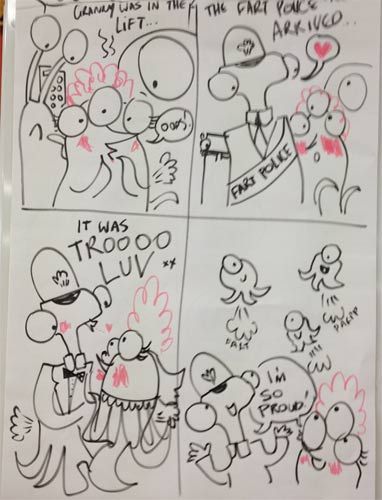
The second day I did a big pirate assembly for the younger kids, and it was very boisterous, in a good way, with lots of kids giving me their best ARRRRRs. 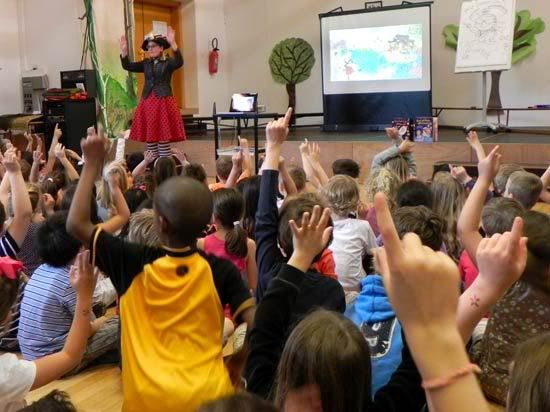
Photo by Susan Boller
Here's the pirate captain they helped me draw. As always, a paragon of good hygiene and taste. That's the head librarian at the top, Marie-Pierre Preece (or 'MP', as she prefers to be called) and assistant librarian Susan Boller. 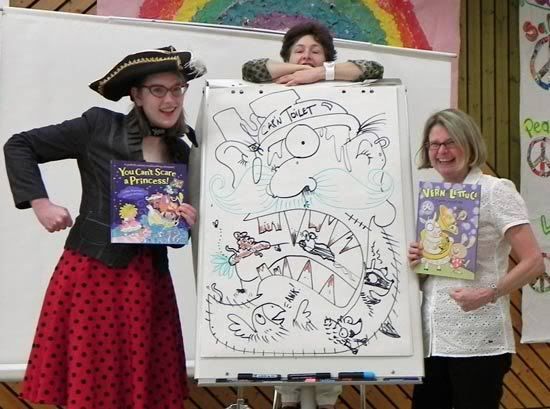
Oh, and some more comics! 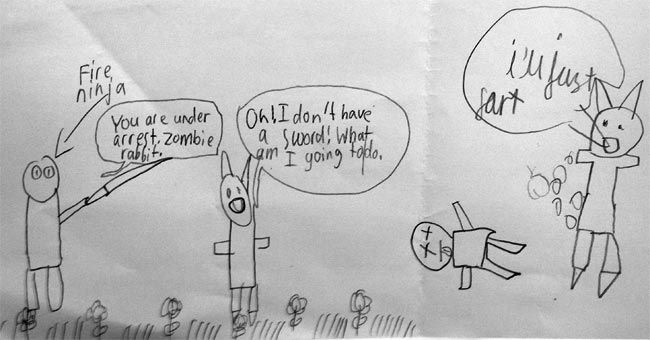
A couple of comics were even more rude, and MP asked me to tone it down a bit, so they could still post them up for parents to see. It's always a conundrum: do you have kids make stuff that will look good on the bulletin boards, or do you let them revel in total rudeness and think they're being terribly naughty, without realising that they're actually teaching themselves to read and write? It's a fine balance. Here's the picture I drew in the library guest book.
The guest book had lots of other illustrious names in it! Here are entries by Nicholas Allen (I love his book The Queen's Knickers, former Children's Laureate
Cel Shading Experiment with Particular by Mattias Peresini (France)
History of Graphic Design Avant Garde by Minji Aye Hong (US)
Bacon Bros by Timothy Merks (US)
Roaster by Blobby Barack (France)
LeMob studio promo clip by Bart Wasem (Switzerland)
Cartoon Brew: Leading the Animation Conversation |
Permalink |
No comment |
Post tags: Bart Wasem, Blobby Barack, France, Mattias Peresini, Minji Aye Hong, Switzerland, Timothy Merks, US
Rancho Girl by Jorge Ruiz (USA/Venezuela)
Various Fluid Experiments by Vladimir Jankijevic (Switzerland)
Myslivci by Jan Saska (Czech Republic)
SVA Dusty Animation Night Intro by Kaukab Basheer (USA/India)
“Bully” Album Teaser by A3+ (France)
Browse through the Animated Fragments on Cartoon Brew or subscribe to our channel on Vimeo to see most of them.
Cartoon Brew: Leading the Animation Conversation |
Permalink |
No comment |
Post tags: A3+, Czech Republic, France, India, Jan Saska, Jorge Ruiz, Kaukab Basheer, Switzerland, Venezuela, Vladimir Jankijevic
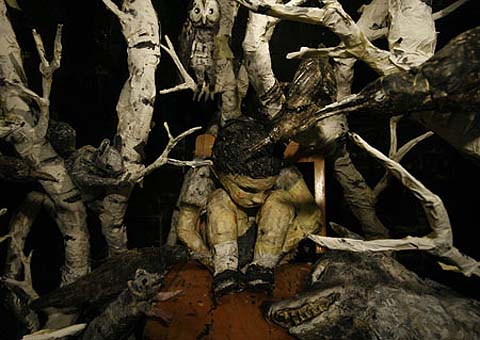
“In a room there is a box. In the box there is a forest. In the forest there is a lost child.” The Smaller Room (Der Kleinere Raum, 2009) by Cristobal Leon and Nina Wehrle may be short, but its claustrophobic and foreboding atmosphere leaves an impression on the viewer.
(via Jeff Scher’s Twitter)
Cartoon Brew: Leading the Animation Conversation |
Permalink |
No comment |
Post tags: Cristobal Leon, Nina Wehrle, Switzerland
Zurich, Switzerland based Philipp Dornbierer, a.k.a. Yehteh, is a digital illustrator and designer. Philipp has a great way of basing his work around rather doomy symbolism, such as swords and hooded executioners, but juxtaposes them with bright colors, pleasing patterns, and some friendlier icons to create joyfully accessible imagery. Some of my favorites include his collaborations with stateside’s Andy J. Miller. With a client list including Carhartt, IBM, and 55DSL, I think we can expect to see a lot more great things from this guy in the near future.
Philipp has iPhone cases + prints available for purchase in his Society6 shop.
(via The Fox is Black)
——————–
Also worth viewing:
Olimpia Zagnoli
Naive: Modernism & Folklore in Graphic Design
Not signed up for the Grain Edit RSS Feed yet? Give it a try. Its free and yummy.
——————–
No Tags Add a Comment
Tom Schifanella is Senior VP/Executive Creative Director for The Robin Shepherd Group and a passionate collector of hotel luggage labels. I highly recommend his Flickr stream which is filled with amazing examples of these labels and other travel-related ephemera. Tom also handles the collection of the late Gyorgy Razso, a Hungarian who amassed one of the biggest luggage label collections in the world. Many of the labels from the collection are available for purchase here.
(via the excellent Aqua-Velvet)
——
If you like this, check out: Istanbul Luggage Label, Swiss Luggage Label
Not signed up for the Grain Edit RSS Feed yet? Give it a try. Its free and yummy.
——
No Tags
Patrick Eberhard has amassed an amazing collection of Swissair-related material. His website, Sr692 which is named after the flight number from Zürich to Lisbon, is filled with vintage posters, flyers, logos, stamps, route maps, tickets and books, as well as a detailed history of the airline. This is an absolute goldmine for those interested in Swiss design.
A hat tip to Shelby at Wanken for discovering this amazing resource.
(via iso50 + Delicious Industries)
——————–
Recommended Reading:
Airworld: Design And Architecture For Air Travel - Published by Vitra
This book focuses on the corporate design of airlines, uniform fashion, the graphics of air travel posters and the significant role that aviation played as an inspiration for architecture, design and art up to the present day.
Copies are available at Amazon.
——————–
Also worth viewing: Swiss Graphic Design by Geigy, Jorg Hamburger, Publicity and Graphic Design in the Chemical Industry.
Not signed up for the Grain Edit RSS Feed yet? Give it a try. Its free and yummy.
——————–
No Tags
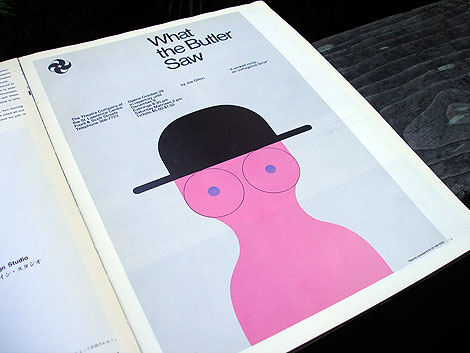
Poster for the Theatre Company at the St. Lawrence Centre
Gottschalk + Ash was founded in Montreal in 1966 by Swiss-born Fritz Gottschalk and Canadian native Stuart Ash. Independently and collaboratively, the two have racked up numerous design awards and honors over the last 40 years, with highlights that include identity work for Ciba and a re-design of the Swiss passport. Their work shown above is a great example of Swiss precision and a playful, more humanized take on design.
Galileo poster for the Theatre Company at the St. Lawrence Centre
Poster for the Theatre Company at the St. Lawrence Centre
Polypropylene booklet for Shell
Four Seasons annual report 1970
Further Reading:
Stuart Ash at Aqua-Velvet, Fritz Gottschalk at Aisle One, Gottschalk + Ash at the Canadian Design Resource
——————–
Also worth viewing: Jacques Charette
Not signed up for the Grain Edit RSS Feed yet? Give it a try. Its free and yummy.
——————–
No Tags
Really looking forward to the release of The Visual Language of Herbert Matter. It’s due to hit theaters this summer. The film was a finalist in the SXSW title design competition and the poster (designed by Cristiana Couceiro) just won a Merit Award at the 3 x 3 Professional Illustration Show.
From the website:
With the help of historical footage, vintage photographs, never-before-seen film excerpts (some shot by Matter himself) and a broad overwiew of his extensive body of work, the feature length documentary helps in bringing the picture of an almost forgotten creative genius back into focus.
Interwoven with interviews from a who’s who list of legendary artists, designer and photographers, the film sheds light on a remarkable career and its impact on the evolving language of design during the short 20th century both in the USA and Europe.
For the first time in an encompassing and comprehensive way, the film touches on the innovative expressions of his free experimental work, his fashion and advertising photography and his portraiture. His amazing talent of combining bold combinations of words, images and space is shown in his iconic Swiss travel posters, pavilion designs for the New York World’s Fair 1939, photographs for Condé Nast publications; corporate image programs for Knoll furniture, the New Haven Railroad, exhibition- and numerous catalog designs for the Museum of Modern Art and the Guggenheim Museum; covers for the legendary Arts & Architecture magazine and his lesser known work in film, the prime example being a film on the works of Alexander Calder.
——————–
Also worth checking: Swiss Graphic Design by Geigy, Jorg Hamburger, Hans Hartmann, Zurich Map
Not signed up for the Grain Edit RSS Feed yet? Give it a try. Its free and yummy.
——————–
No Tags Add a Comment
I was leaving Matala with Anne and Thomas, the dedicated communist German from Ulm, who owned the French Peugot which elevated and lowered its suspension at the flick of a switch. He and I had argued about communism and democracy for a week every night in the taverna. My strongest argument, the one which he couldn’t answer, was to ask him where all the communist travellers were? Why was he the only one from a communist country who was free to travel where he liked, do what he wanted?
Thomas’ idealism was admirable. We agreed, at least, that the rich, communist or capitalist, were still screwing the poor. He owned a car and offered me a free ride to Iraklion when he learned I was leaving.
Anne was leaving Greece, too. She was from England, I was heading for London. She had seen me around Matala, decided to accompany me.
I collected the drachma which were saved for me by my boss, Costa, the young, local godfather in Matala. He gave me an allowance each week, kept back a portion of my pay. I worked on various construction jobs he had, was hardened, tanned and strong when he paid me off.
He held back a bit for himself, just to make sure everyone knew who was the boss. If he hadn’t saved some of my pay for me, we both knew I would have blown it all.
The ferry from Iraklion to Piraeus was boring and uneventful. Just as well. After living for six months in Matala, on the southern coast of Crete, never leaving, it was a slow emergence into the outside world.
One of the most embarrassing occasions in my life occurred just then. I had the crabs. I got them in Matala and was at the stage of exterminating them which required sexual abstinence. There was to be no carnal contact, not even snuggling, in case of infection of another and a rebirth of the cursed bugs. But I was ashamed. I was too embarrassed to tell Anne.
God knows what she thought.
Anne had lived in Matala long enough to know that I wasn’t gay. She was attractive enough, the ex girlfriend of a guy who was the grandson of Robert Graves, the poet.
But I passed up perfect opportunities and situations which thrust us together. You don’t get much closer together than when you hitchike together. I had recently been through hell, living in my makeshift tent in the campground, scratching at myself. I wouldn’t have wished it on anyone. But I couldn’t bring myself to tell her.
It was bad enough telling Costas and the boys in Matala. They all took a step away from me.
Costas wrinkled his nose when he asked why I didn’t tell him sooner. Later, he admitted that when he got them, he separated himself from his family home and friends until he got rid of them.
After a few smog filled days in Athens during which we were treated as fair game, ripped off everywhere we turned, we concluded that the air fare to Britain was too costly. There was an election on in Greece, something catastrophic was happening in Northern Europe, living in Athens, even on our skimpy budget, was too expensive. Reaching London could be done, cheaper, by hitching most of the way.
Anne was fighting with her parents, proving her independence. She could easily get the required air fare home but refused to make the call, thereby signalling to her family that she was dependent upon them.
I thought she was crazy.
A guy seemed to meet us in Brindisi, when we landed in Italy. He appeared, smiling like a long lost brother, gave us pizza and a room for the night, ostensibly, for free. He finally demanded payment in sexual favours, from Anne, but too late. By the time he sneaked away from his wife, it was morning and we fled.
On the motorway, heading north, it was easy to see why veteran travellers advised always to hitch with a woman in Europe. Even eighteen wheelers with full loads stopped for women.
The first big rig which came by, skidded to a fishtailing halt, up the highway. The driver didn’t care about the truck, t